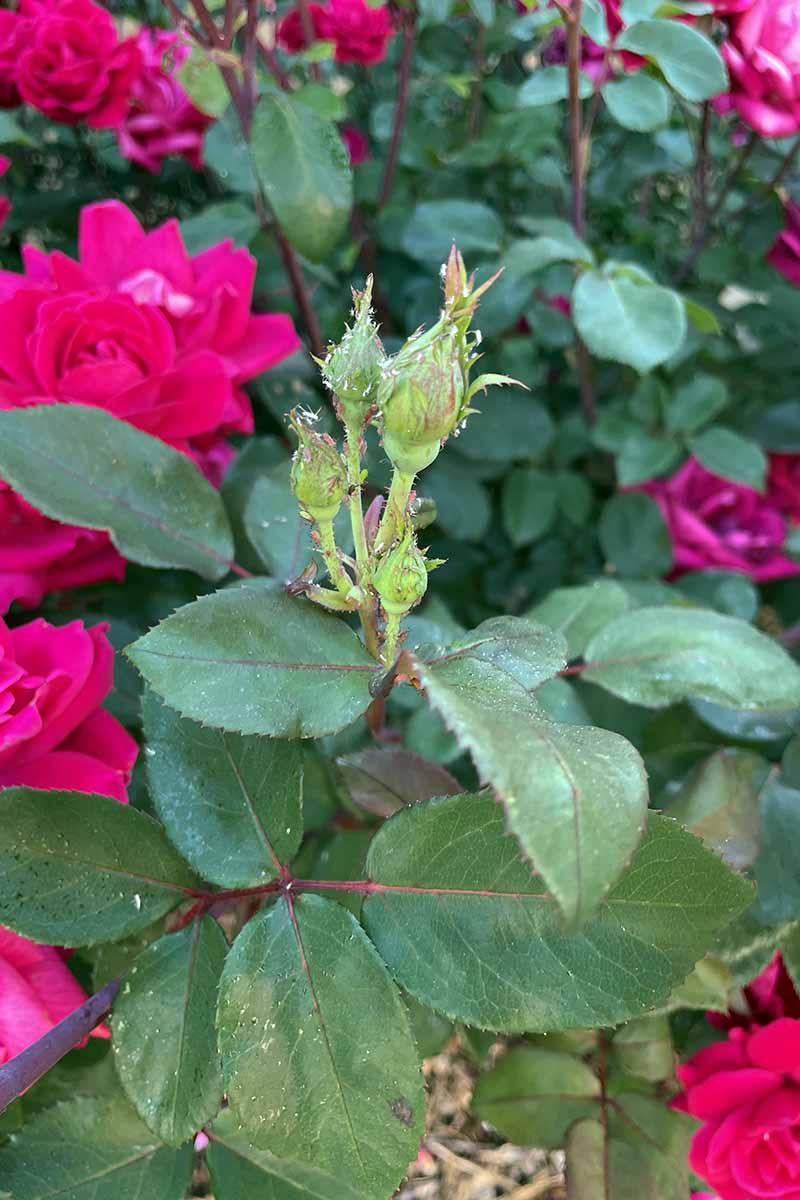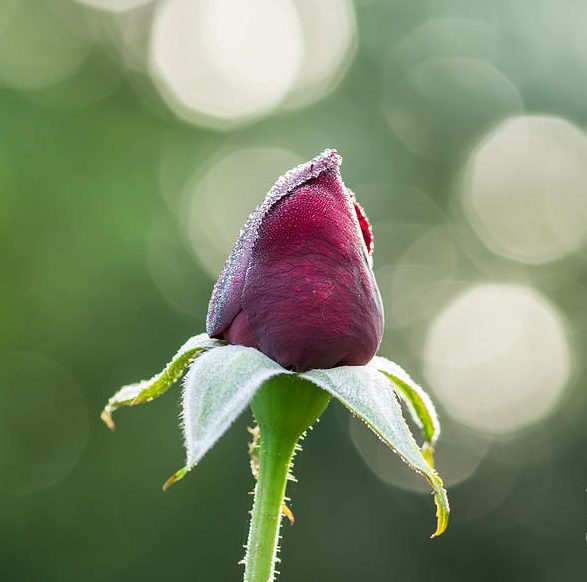
Too much nitrogen fertilizer is typically the cause of roses that are not in bloom. An abundance of nitrogen encourages the growth of foliage at the expense of flowers, resulting in lanky growth with no blossoms. Lack of light, pests, and improper trimming can all prevent rose bushes from blooming.
In order of most likely cause, I’ve listed each reason why roses may bloom less frequently or not at all.
The most typical causes of roses not blooming are:
- applying fertilizer excessively regularly or in excess.
- nutrient-deficient soil
- pests like aphids that feed on the developing flower buds’ sap.
- excessive shade (roses bloom to their best in full sun of at least 6 hours).
- avoiding yearly rose pruning (rose has turned woody with few blooms).
- incorrect timing of rose trimming (certain types only flower on the previous year’s growth, therefore spring pruning can prevent the rose from flowering).
Continue reading to learn the cause of your rose’s lack of blooming and how to fix it so that it does so the next Spring.
Table of Contents
1. Too Much Nitrogen (Scale back the Fertilizer)
Too much nitrogen from frequent or high-intensity fertilizer usage is perhaps the most frequent cause of roses not flowering properly or to their full potential.
Nitrogen, phosphorus, and potassium (NPK) are essential for all plants to grow healthily, but an excess of nitrogen in the soil can encourage leaf growth at the expense of flowers.
Your roses’ stems, branches, and leaves start to sag and droop as a result of the excess nitrogen, which is a sign of stress. (Also a sign of too much nitrogen are yellow leaves.)
It is crucial to use the proper amount of fertilizer for rose bushes because the excessive new growth makes them more vulnerable to pests, illnesses, and frost damage.
Personally, I advise using a fertilizer developed especially for roses because it has the precise ratio of nutrients needed for roses to grow and bloom, eliminating any uncertainty and risk associated with using a more general fertilizer.
Reduce fertilizer use and cut back any drooping growth if your rose has abundant foliage but few flowers as a result of overfertilization, especially if the leaves have turned yellow.
If you reduce the amount of fertilizer you apply on the rose to a more acceptable level by following the manufacturer’s directions, there is every chance that the rose bush will recover the next season and produce blossoms.
2. Nutrient Poor Soil
Due to a lack of nutrients, roses grown in nutrient-poor, sandy soils cannot blossom. Since roses consume a lot of food, it’s crucial to have the proper nutrient balance.
The amount of resources that may be absorbed by the roots may be limited in sandy or stony soils because they do not hold much moisture or nutrients. As a result, the rose develops a sickly appearance, has weak development, and produces few to no summer flowers.
How to Fix It
In sandy or stony soils, roses can flourish if the soil has been properly prepared prior to planting.
Rose-friendly soil preparation techniques include:
- Adding a lot of organic stuff to the planting area before you start planting. The soil benefits greatly from the addition of compost, leaf mold, and well-rotted manure because they are all good moisture and nutrient retainers.
- To conserve moisture, replicate the ecosystem of the soil, add nutrients, and enhance the soil’s structure for roses, spread a 1-inch layer of mulch around the rose.
If it is not possible to transplant your rose since it has already been planted and grown in slightly sandy or stony soil, you may either try to carefully dig around the rose with a fork while removing some of the sandy or rocky dirt to add compost to the soil.
Or you may just consistently apply mulch and use fertilizer to make up for the deficiency of nutrients in the soil.
Mulch should be used early in the spring to aid in water conservation over the summer and late in the fall to protect the roots from freezing temperatures in the winter.
Mulch applications have a significant impact on the soil’s nutrient density over time, and they also significantly aid to improve the soil’s structure, which favorably affects the health and appearance of roses.
The rose will be well-positioned to produce flowers the following Spring thanks to the extra nutrients and raised moisture content of the soil from mulching.
3. Pests Attacking the Rose Buds (Aphids)

The aphid is the insect pest that affects rose flowers most frequently.
These tiny, green insects are a major issue because they are drawn to the budding buds of rose blooms and feed on the sap of roses.
The aphids damage the leaves and flowers, which can stymie their growth and result in a subpar flower show.
Most gardens have some aphid activity, but predatory insects like lady bugs normally keep their numbers in check and, consequently, their potential for damage.
Because nitrogen fertilizer causes plants to produce more sap and softens their tissue, aphids find sap on roses to be particularly bothersome because the sap is easier for the aphids to get.
Save Rose Blooms from Aphids
Careful observation is the key to protecting your rose flower buds from an aphid attack.
Early in the spring or summer, if you notice aphids swarming around your rose buds, you can take action before they cause serious harm to the blossoms.
How to deal with an aphid infestation on rose buds:
- With your hands or some gentle but firm shaking, knock the aphids off the rose buds! Once they are on the ground, predatory insects and birds can easily catch them.
- As long as the pressure from the hose pipe is not so high that it harms the rose, it is permissible to blow the aphids away.
- Apply an organic insecticidal soap to the rose, paying particular attention to the buds.
- Instead of employing chemical pesticide sprays that indiscriminately kill beneficial insects that feast on aphids (such as lady bugs), which naturally limit the aphid population, promote a healthy garden environment with “bug hotels.”
As you can see from the photo, my own rose had a lot of aphids. However, by monitoring my rose in the spring and manually removing any aphids, I was able to reduce the damage.
This is a really efficient method of solving the issue, and the following year, my Rosa ‘Burgundy Ice’ was able to produce a stunning bloom.
4. Lack of sun (Roses Bloom Best with 6+ hours of Sun)
Roses grow best when planted in full sunlight (at least 6 hours of sun per day).
Too much shade causes roses to become leggy in quest of more light, which results in fewer blooms and a lanky appearance.
The only options are to move the rose to an area of your garden that receives more sunlight or to trim back any overhanging tree branches that may be shading the rose.
The best practice is to space roses about three feet apart to give you room to move around the rose for pruning and routine deadheading, which increases the number of blooms. This ensures the rose has enough light and thus energy to bloom and reduces the risk of fungal disease by increasing airflow around the foliage.
One of the most critical factors affecting how well rose bushes bloom and vital for disease resistance is the amount of sunlight.
(Read my article on selecting the best rose pots.)
5. Lack of Consistent Pruning
An essential part of rose care is annual pruning, which keeps your rose from getting too woody and producing few flowers.
Once a year pruning encourages the creation of new stems and branches that support more blooms because older, leggy wood might become less effective at producing flowers.
Regular deadheading is essential to encourage rose blooms in addition to annual trimming since doing so encourages the rose to create more blossoms rather than using that energy to generate seeds (rose hips).
Roses can become lanky and produce fewer blossoms if they are neglected. Because the wood might grow brittle in the winter, the resulting woody rose is more vulnerable to injury.
Even if you haven’t pruned your rose in a few years, it can still be revitalized with careful pruning to remove dead wood, enhance the appearance, and promote blossoms.
Here is a YouTube video that shows how to prune neglected roses since it is necessary to give a visual explanation when pruning woody roses.
6. When to Prune Your Rose for More Blooms
If you prune a rose variety in the spring, you might be removing the developing blossoms, which would prevent the rose from blooming until the following year. Some rose kinds exhibit their flowers on the previous year’s growth.
Regular deadheading throughout the season and branch pruning in the winter for roses that repeat flower keep the rose bush neat and prevent cutting off any developing flower buds or wood that will serve as the host plant the following year.
After the bush has completed blossoming in the late summer, trim the rose kinds that only bloom once a year.
– Alfalfa. … An organic insecticidal soap should be sprayed on the rose, concentrating on the buds.
Key Takeaways:
- Instead of using chemical pesticides that indiscriminately kill beneficial insects that feast on aphids (such as lady bugs), which naturally limit the aphid population, promote a healthy garden environment with “bug hotels.”
- Since I checked my rose in the spring and manually removed any aphids, as you can see from the photo, I was able to reduce the damage.
- This approach to the issue is highly successful, and the next year, my Rosa ‘Burgundy Ice’ was able to produce a magnificent bloom.
- When grown in full sunlight, roses blossom at their finest (at least 6 hours of sun per day).
- Insufficient light causes roses to grow leggy and produce fewer blooms while also giving them a more spindly appearance.
- There are only two ways to fix this: either move the rose to a part of your garden that receives more sunlight, or trim back any overhanging tree branches that might be shading the rose.
